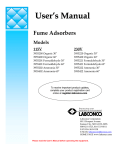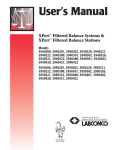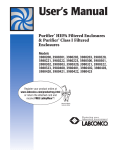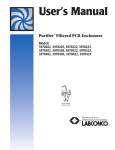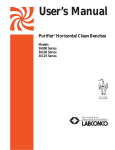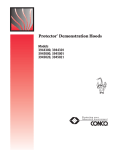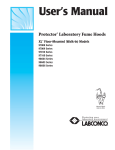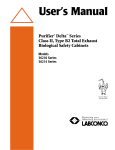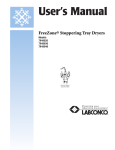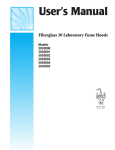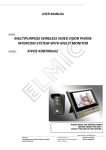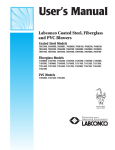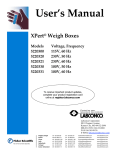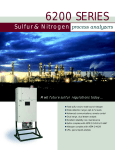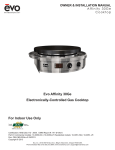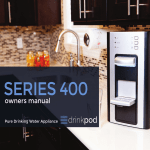Download FilterMate Manual Cover
Transcript
User’s Manual FilterMate™ Portable Exhausters Models 3970000 3970001 3970002 3970003 3970004 3970020 3970021 3970022 3970023 3970024 Labconco’s Mascot, Labby the LABster For more information, please contact us: ExpotechUSA 10700 Rockley Road Houston, Texas 77099 USA 281-496-0900 [voice] 281-496-0400 [fax] E-mail: [email protected] Website: www.ExpotechUSA.com Labconco FilterMate™ Portable Exhausters Manual Warranty Labconco provides a warranty on all parts and factory workmanship. The warranty includes areas of defective material and workmanship, provided such defect results from normal and proper use of the equipment. The warranty for all Labconco products will expire one year from date of installation or two years from date of shipment from Labconco, whichever is sooner, except the following: • • • Purifier® Delta® Series Biological Safety Cabinets and PuriCare™ Animal Laboratory Research Enclosures carry a three-year warranty from date of installation or four years from date of shipment from Labconco, whichever is sooner. Carts carry a lifetime warranty. Glassware is not warranted from breakage when dropped or mishandled. This limited warranty covers parts and labor, but not transportation and insurance charges. In the event of a warranty claim, contact Labconco Corporation or the dealer who sold you the product. If the cause is determined to be a manufacturing fault, the dealer or Labconco Corporation will repair or replace all defective parts to restore the unit to operation. Under no circumstances shall Labconco Corporation be liable for indirect, consequential, or special damages of any kind. This statement may be altered by a specific published amendment. No individual has authorization to alter the provisions of this warranty policy or its amendments. Lamps and filters are not covered by this warranty. Damage due to corrosion or accidental breakage is also not covered. Limitation of Liability The disposal and/or emission of substances used in connection with this equipment may be governed by various federal, state, or local regulations. All users of this equipment are required to become familiar with any regulations that apply in the user’s area concerning the dumping of waste materials in or upon water, land, or air and to comply with such regulations. Labconco Corporation is held harmless with respect to user’s compliance with such regulations. . Part #3922700, Rev. A ECO C573 TABLE OF CONTENTS CHAPTER 1: INTRODUCTION About This Manual Typographical Conventions 1 3 4 CHAPTER 2: PREREQUISITES Electrical Requirements Ground Fault Interrupter Exhaust Requirements for the FilterMate Location and Preparation Requirements Your Next Step 5 5 6 6 7 8 CHAPTER 3: GETTING STARTED Unpacking Your FilterMate Setting Up Your FilterMate Initial Installation of HEPA Filters and Carbon Filters Carbon Filters Combination HEPA/Carbon Filters Dual Carbon Connect the Electrical Supply Source to FilterMate Set the Face Velocity with Speed Control Adjustment 9 9 10 13 13 13 14 20 20 CHAPTER 4: USING YOUR FILTERMATE Suitable Applications Applications for the FilterMate Definition of Terms Appropriate Chemicals Use of Chemical Carcinogens in the FilterMate Acids Must not Be Used Safety Precautions HEPA FilterMate Equipped with HEPA Filter Misapplications that could result in a Hazardous Situation 21 21 22 22 23 24 25 25 27 28 CHAPTER 5: MAINTAINING YOUR FILTERMATE Monthly Determination of when to Replace Carbon Filters Determination of when to Replace HEPA Filters Install New HEPA Filter with Bag-In/Bag-Out Procedure FilterMate HEPA Filter Leak Test Motorized Impeller Replacement Speed Control Replacement 29 29 30 32 32 34 36 36 CHAPTER 6 MODIFYING YOUR FILTERMATE Converting a Room Exhaust HEPA FilterMate to Outside Exhaust Converting a Combination HEPA/Carbon FilterMate to a Dual Carbon FilterMate Converting a HEPA FilterMate to a Combination HEPA/Carbon FilterMate 37 37 38 38 CHAPTER 7 TROUBLESHOOTING YOUR FILTERMATE 39 APPENDIX A: FILTERMATE COMPONENT AND REPLACEMENT PARTS 41 APPENDIX B: FILTERMATE SPECIFICATIONS Electrical Specifications Environmental conditions Dimensions Wiring Diagram 45 45 45 47 49 APPENDIX C: FILTERMATE RESOURCES 51 DECLARATION OF CONFORMITY 52 CHAPTER 1 INTRODUCTION Congratulations on your purchase of a FilterMate™ Portable Exhauster, which exhausts filtered air. Labconco manufactures ten models of the FilterMate. These ten models consist of variations of HEPA filtration, carbon filtration, HEPA filtration to outside exhaust, combination HEPA/Carbon filtration and combination carbon/carbon filtration. All of these units are offered in 115V, 50/60 Hz operations or 230V, 50/60 Hz operations. The Labconco FilterMate is an accessory for the Labconco Protector® XVS Ventilation Stations and XPert Balance Enclosures. When the FilterMate is connected to the Protector XVS or XPert, enclosure conforms to ANSI/AIHA Z 9.5 – 1993, ETL and ETL-C, ASHRAE 110-95, and NFPA-45 (except carbon filters). In addition the 230V, 50/60 Hz models carry the CE mark. Carbon filters are sold separately and HEPA filters are included on HEPA-filtered models. The FilterMate provides the necessary airflow (CFM) to an enclosure such as Protector XVS Ventilation Station or XPert Balance Enclosure. The XPert Balance Enclosure or Protector XVS Ventilation Station protects the operator from vapors and/or particulates released during chemical, powder or biological procedures performed within the enclosure. For biological and powder work, the FilterMate must be equipped with a HEPA filter, and is NOT to be used with biologically hazardous materials. For volatile material, the FilterMate must be equipped with a carbon filter or be exhausted outside the building. As the air moves through the enclosure, vapors or particulates emitted within the enclosure are drawn through a rear baffle, where 1 Chapter 1: Introduction they are mixed with and diluted by room air. This contaminated air is then drawn into the FilterMate where HEPA filters remove particulates. Vapors are adsorbed in activated or impregnated carbon filters. For applications requiring carbon filtration, it is recommended that the FilterMate be allowed to operate at lower speeds of 60 to 80 feet per minute to allow adsorption of volatiles and prevent material breakthrough back into the air. Additionally, the FilterMate’s built-in speed control is capable of reducing the face velocity to 60-80 fpm, so that analytical and microbalances may be used. Purified air is drawn from the filters, through the fan and returned to the room or exhausted outside through a thimble connection. For most applications, the FilterMate does not exhaust filtered air from the room unless required by your Safety Officer. The HEPA filter must be installed before the carbon filters for applications with light duty chemical use. For only volatile chemical use, the Carbon FilterMate is used. For hazardous biological applications, Labconco recommends the purchase of a Class I or Class II biological safety cabinet. Contact Labconco for biological safety cabinet ordering information. See chart below: Application Powders & Particulates Product FilterMate Filters HEPA Volatile Chemicals (Low level) FilterMate Carbon* Powders & Particulates & Volatile Chemicals FilterMate HEPA and Carbon* Non-Hazardous Bio FilterMate HEPA Hazardous Bio Class I & Class II HEPA *It is strongly recommended that a Labconco product specialist review the chemical application to determine if it is suitable. 2 Chapter 1: Introduction About This Manual This manual is designed to help you learn how to install, use, and maintain your FilterMate. Instructions for performing routine maintenance and making minor modifications to your FilterMate are also included. Chapter 1: Introduction provides a brief overview of the FilterMate, explains the organization of the manual, and defines the typographical conventions used in the manual. Chapter 2: Prerequisites explains what you need to do to prepare your site before you install your FilterMate. Chapter 3: Getting Started contains the information you need to properly unpack, inspect, install, and test your FilterMate. Chapter 4: Using Your FilterMate discusses the basic operation of your FilterMate. Chapter 5: Maintaining Your FilterMate explains how to perform routine maintenance on your FilterMate and check the HEPA and carbon filters. Chapter 6: Modifying Your FilterMate explains how to modify and change your FilterMate. Chapter 7: Troubleshooting contains a table of problems you may encounter while using your FilterMate, including the probable causes of the problems, and suggested corrective actions. Appendix A: FilterMate Components and Replacement Parts contains labeled diagrams of all of the replacement parts and components for the FilterMate. Appendix B: FilterMate Specifications contains electrical specifications, environmental conditions, dimensions and wiring diagrams. Appendix C: FilterMate Resources. 3 Chapter 1: Introduction Typographical Conventions Recognizing the following typographical conventions will help you understand and use this manual: • • • ! ☞ HEPA CARBON HEPA SYSTEM COMBO 4 • • Book, chapter, and section titles are shown in italic type (e.g., Chapter 3: Getting Started). Steps required to perform a task are presented in a numbered format. Comments located in the margins provide suggestions, reminders, and references. Critical information is presented in boldface type in paragraphs that are preceded by the exclamation icon. Failure to comply with the information following an exclamation icon may result in injury to the user or permanent damage to your FilterMate. Important information is presented in capitalized type in paragraphs that are preceded by the pointer icon. It is imperative that the information contained in these paragraphs be thoroughly read and understood by the user. • Contains information specific to the HEPA FilterMate for exhausting to the room. • Contains information specific to the Carbon FilterMate for exhausting to the room. • Contains information specific to the HEPA System FilterMate for exhausting filtered air to the outside. • Contains information specific to combination HEPA/Carbon FilterMate for exhausting to the room. CHAPTER 2 PREREQUISITES Before you install your FilterMate and XPert or XVS Enclosure, you need to prepare your site for installation. Carefully examine the location where you intend to install your FilterMate and enclosure. You must be certain that the area is reasonably level and of solid construction. An electrical source must be located near the installation site. Carefully read this chapter to learn: • • • the electrical supply requirements. the exhaust requirements. the location and preparation requirement. Refer to Appendix B: FilterMate Specifications for complete FilterMate electrical, dimensions, environmental conditions, specifications and requirements. Electrical Requirements Both the 115V and 230V FilterMate require 10 amp circuits. The motor/blower uses 2A and the switched auxiliary outlet has a maximum capacity of 8A. 230V model is shipped without a plug and the customer must install the appropriate plug used in their installation. If an airflow monitor is used with the enclosure, it is recommended that the airflow monitor be connected directly to the FilterMate’s auxiliary outlet so the airflow monitor is powered at the same time. If this is not possible, the airflow monitor may be connected to the auxiliary outlet on the accessory fluorescent light. 5 Chapter 2: Prerequisites ! CAUTION: This equipment must be grounded (earthed). Ground Fault Interrupter ☞ WHEN CONNECTING THE FILTERMATE TO A GROUND FAULT INTERRUPTER CIRCUIT (GFIC), ENSURE THAT THE CIRCUIT IS RATED FOR 15-AMP LOAD AND IS FUNCTIONING CORRECTLY. CONNECTION OF THE FILTERING SYSTEM TO A LOWER CAPACITY OR DEFECTIVE GFIC MAY RESULT IN EXCESSIVE ACTIVATION OF THE GFIC, CUTTING POWER TO THE FILTERMATE WHILE IT IS OPERATING. Exhaust Requirements for the FilterMate (Filtered Room Exhaust or Outside) The FilterMate is capable of exhausting up to 280 cfm of HEPA filtered air or up to 220 cfm of combination HEPA/Carbon filtered air. These airflows are achieved when connected to the enclosure with an 8' length of 5" hose. For lower airflows adjust the speed control on the back of the FilterMate. Labconco offers HEPA and Carbon FilterMate models listed below. FilterMate Catalog Number 3970000 3970001 3970002 3970003 3970004 3970020 3970021 3970022 3970023 3970024 6 Voltage 115 Volt/60 Hz 115 Volt/60 Hz 115 Volt/60 Hz 115 Volt/60 Hz 115 Volt/60 Hz 230 Volt/50 Hz 230 Volt/50 Hz 230 Volt/50 Hz 230 Volt/50 Hz 230 Volt/50 Hz Filter HEPA Carbon HEPA HEPA/Carbon Carbon/Carbon HEPA Carbon HEPA HEPA/Carbon Carbon/Carbon Exhaust Airflow (cfm) (max) 280 280 280 220 220 280 280 280 220 220 Exhaust Connection None None Canopy to outside None None None None Canopy to outside None None Chapter 2: Prerequisites If the FilterMate exhaust is to be connected to the house exhaust system, it is recommended that 3970002 (115 Volt) or 3970022 (230 Volt) be ordered with thimble connections. The 6" diameter thimble connection allows you to easily balance the exhaust airflow. HEPA Filter Part #3707900 is 99.99% efficient on particles 0.3 micron. Normal life expectancy is two to five years. See Chapter 5 for filter changing procedure. HEPA Filter Bag-In/Bag-Out Bag Part #3779002. Ensures containment of particulate matter during filter changing operations. Carbon Filters Provides the listed amount of granular activated carbon or treated carbon. For estimated filter life, consult a Labconco Technical Specialist and Labconco’s Chemical Guide. Filter Classification Organic Vapors Formaldehyde Ammonia Catalog # 3923400 3923401 3923402 Carbon lbs. 12# activated carbon 14# treated carbon 16# treated carbon Room Air Exchanges – For carbon-filtered models, accumulation of vapor contaminants from the exhaust can be harmful when the Rate of Generation exceeds the Rate of Room Exhaust. For a saturated carbon filter the following mathematical equation can be used to determine the minimum room exhaust rate: ! Inlet Vapor Concentration (PPM) x FilterMate Airflow in CFM < TWA (PPM) x Room Exhaust (CFM) By equating both sides of the equation, the unknown will be the required air changes in order to not exceed the TWA (Time Weighted Average) for the chemical. Location and Preparation Requirements When the FilterMate is connected to an enclosure, the enclosure should be located away from drafts, traffic patterns, doors, fans, ventilation registers, fume hoods, and any other air handling 7 Chapter 2: Prerequisites device that could disrupt its airflow patterns. All windows in the room adjacent to the enclosure should be closed. The FilterMate may be placed anywhere close to the enclosure. It may be bench mounted, placed on the floor or suspended on a shelf nearby. 8 CHAPTER 3 GETTING STARTED Now that the site for your FilterMate is properly prepared, you are ready to unpack, inspect, install, and test your FilterMate. Read this chapter to learn how to: • • • • • • unpack and move your FilterMate. set up your FilterMate. connect 5" hose and exhaust transition. install filters. connect the electrical supply source to your FilterMate. set the face velocity with the speed control adjustment. Tools required are: flat bladed and Phillips screwdrivers, ratchet, deep socket set and power screwdriver. A small flat bladed screwdriver is required to adjust speed control. An anemometer is required to adjust the face velocity for the Protector XVS Ventilation Station or XPert Balance Enclosure. Unpacking Your FilterMate Carefully unpack your FilterMate and inspect it for damage that may have occurred in transit. If your FilterMate is damaged, notify the delivery carrier immediately and retain the entire shipment intact for inspection by the carrier. ☞ The United States Interstate Commerce Commission rules require that claims be filed with the delivery carrier within fifteen (15) days of delivery. DO NOT RETURN GOODS WITHOUT THE PRIOR AUTHORIZATION OF LABCONCO. UNAUTHORIZED RETURNS WILL NOT BE ACCEPTED. 9 Chapter 3: Getting Started ☞ IF YOUR FILTERMATE WAS DAMAGED IN TRANSIT, YOU MUST FILE A CLAIM DIRECTLY WITH THE FREIGHT CARRIER. LABCONCO CORPORATION AND ITS DEALERS ARE NOT RESPONSIBLE FOR SHIPPING DAMAGES. Do not discard the carton or packing material for your FilterMate until you have checked all of the components, installed, and tested the FilterMate. Setting Up Your FilterMate, Installing 5" Hose and Exhaust Transition Move the FilterMate to the location where you want to install it. Then follow the steps listed below if connecting to a Protector XVS Ventilation Station or XPert Balance Enclosure. 10 • If a Protector XVS or XPert Enclosure has been purchased, place it on a suitable work surface. There should be no gaps between the work surface and the bottom of the enclosure. • Locate the FilterMate within approximately 3-feet (1 meter) of the enclosure. The FilterMate can be located on the bench, floor or shelf above the enclosure. Insert the transition (2" x 10" x 5" diameter hose) exhaust adapter into the exhaust of the enclosure. An alternate location is on the bottom for concealed exhaust. See XPert Balance Enclosure and Protector XVS Ventilation Station Instruction Manual. See Figure 3-2. • Fasten the transition exhaust adapter to the FilterMate with two screws provided. See Figure 3-1. • Place hose over the transition exhaust adapter and clamp securely with one of the two hose clamps provided. Place the other end over the inlet port of the FilterMate and clamp securely. • The FilterMate should be positioned where it provides easy access to the blower switch. Refer to Figure 3-2 for concealed exhaust or outside exhaust ducting. Chapter 3: Getting Started Fluorescent Light Accessory Hose Clamp Enclosure Exhaust Transition Adaptor Recommended Airflow Monitor Accessory 5" ID Hose Hose Clamp FilterMate Exhausted to Room Figure 3-1 Enclosure & FilterMate Top Exhaust 11 Chapter 3: Getting Started Fluorescent Light Accessory Enclosure Recommended Airflow Monitor Accessory (Not Shown) Concealed Lower Exhaust Transition (see enclosure instruction manual) 5" ID Hose 6" Nominal Canopy Exhaust to Outside with Built-In Thimble Connection FilterMate Exhausted to Outside Hose Clamp Figure 3-2 Enclosure & FilterMate Concealed Exhaust Ducted to the Outside 12 Chapter 3: Getting Started Initial Installation of HEPA Filters and Carbon Filters HEPA Filters (For Models 3970000, 3970002, 3970020, 3970022) HEPA HEPA filters are shipped installed with the gasket on the downstream side. The HEPA filters are leak checked at the Labconco factory. A second leak check is recommended before using the FilterMate and at least annually thereafter. Consult your Safety Officer and Chapter 5 for the HEPA Filter Leak Test and HEPA Filter Bag-In/Bag-Out Procedure. See Figures 3-3, 3-4 and 3-5 for HEPA filter location, HEPA filter gasket, filter clamp bolts, rear bag cover and bag-in/bag-out flange. All seams upstream of the HEPA filter are jacketed by negative pressure. This intrinsically safe design ensures containment over time. Carbon Filters (For Models 3970001, 3970021) For carbon filter installation, first remove the rear filter cover, secured by four Phillips head screws, on the back of the FilterMate. See Figure 3-4 for location of the rear filter cover. See Chapters 2 and 3 for a list of available carbon filters. All carbon filters are installed with the gasket side downstream and opposite the clamp bolts. Install the correct carbon filter for the application and tighten the clamp bolts to compress the gasket 50%. See Figures 3-3, 3-4 and 3-5 for carbon filter installation, similar to HEPA filter installation. CARBON Combination HEPA/Carbon (For Models 3970003, 3970023) For combination HEPA/Carbon, the HEPA is installed first with the gasket on the downstream side per Figure 3-5. The carbon filter is installed second in the perforated plenum exhaust cover. COMBO a. The perforated plenum exhaust cover is simply removed via four hole plugs and four captive Phillips head screws. b. Next loosen the two clamps that will support the carbon filter using a wrench. c. Insert the carbon filter with the gasket against the white painted FilterMate main housing. d. Tighten the clamps to compress the gasket 50%. 13 Chapter 3: Getting Started e. Re-install the perforated plenum exhaust cover. See Figures 3-5, 3-6 and 3-7 for combination HEPA/Carbon installation. CARBON Dual Carbon (For Models 3970003, 3970004, 3970023, 3970024) For added carbon capacity or for adsorption of mixed vapors two carbon filters may be installed. Use two carbon filters on dual carbon FilterMate models 3970004 and 3970024. Replace the HEPA filter with a carbon filter on the combination FilterMate models 3970003 and 3970023. This procedure accommodates for Organic Vapor/Formaldehyde, Organic Vapor/Ammonia, or Formaldehyde/Ammonia combinations. Important: Dual carbon filters do not provide any particulate protection. HEPA CARBON 14 Filter Type HEPA 3707900 Organic Vapor Activated carbon 3923400 CARBON Formaldehyde (Formalin) 3923401 CARBON Ammonia and Amines 3923402 Appropriate Use HEPA filters are high-efficiency particulate air filters having a particulate removable efficiency of 99.99% for particles with a diameter of 0.3 micron. Organic compounds designated by NIOSH guidelines as acceptable for use with chemical cartridge type respirators. Concentrations in the enclosure’s work area must not exceed the IDLH for the chemical and the exhaust from the enclosure must not exceed the TWA. Formaldehyde requires the use of an impregnated carbon for the treatment of formaldehyde. Concentrations in the enclosure’s work area must not exceed the IDLH for the chemical and the exhaust from the enclosure must not exceed the TWA. Ammonia, low molecular weight amines and other bases designated by NIOSH as acceptable for use with ammonia cartridge type respirators. Requires the use of an impregnated carbon. Concentrations in the enclosure’s work area must not exceed the IDLH for the chemical and the exhaust from the enclosure must not exceed the TWA. Chapter 3: Getting Started Room Exhaust Cover (remove to leak test HEPA Filter) FilterMate 5" ID Inlet (4) Removable Hole Plugs Exhaust Cover secured by (4) screws Rear Bag Cover Rear Bag Cover Removal Screws (4), #8-32 x .38" Figure 3-3 FilterMate Rear Isometric View 15 Chapter 3: Getting Started Access Clamping Bolts through (2) Hole Plugs on this Side Cover Typical Clamping Bolt CCW-Tighten CW - Loosen Bag-In/Bag-Out Flange Access Port Bag and Retaining Strap Seal here All Around Figure 3-4 Rear Isometric View with Bag Cover Removed 16 Chapter 3: Getting Started Filter Gasket Seals here on downstream side 5" ID Inlet HEPA Filter or Carbon Filter Motorized Impeller Housing Speed Control (4) Captive Screws to Secure Exhaust Cover Filter Clamping Bolt Hole Plug to access Filter Clamping Bolt with 9/16" Socket Airflow Direction Inlet Power Auxiliary Switched Outlet Circuit Breaker(s) Figure 3-5 Rear View 17 Chapter 3: Getting Started Location of (4) Hole Plugs to access screws 5" ID Inlet Fully Perforated Exhaust Cover with extended width to support Carbon Filter Bag Cover Figure 3-6 Combination HEPA/Carbon or Dual Carbon 18 Chapter 3: Getting Started FilterMate Housing (painted white) Carbon Filter Gasket 5" ID Inlet ¼-20 Nylon Lock Nut (4) Carbon Filter Lower Flange of Carbon Clamp to Support Filter Bag Cover Carbon Clamp (2) Figure 3-7 Combination HEPA/Carbon or Dual Carbon with Exhaust Cover Removed 19 Chapter 3: Getting Started Connect the Electrical Supply Source to the FilterMate 115V Simply connect the 115V power cord supplied to the IEC electrical supply plug on the back of the unit. If using 50 Hz operation, blower performance maximum airflow will be reduced by 17%. Refer to Chapter 2 for setting up the building electrical supply. Locate the switched auxiliary outlet on the back for plugging in the airflow monitor. This convenience allows the airflow monitor to be powered by the FilterMate at all times. 230V The above procedure applies for the 230V except it is shipped without a plug. Install the appropriate plug for your electrical specifications per local codes. Set the Face Velocity with the Speed Control Adjustment Adjustment of the speed control gives the correct face velocity when the FilterMate is connected to a Protector XVS Ventilation Station or XPert Balance Enclosure. The face velocity should be adjusted from 60 to 100 fpm. (Consult your Safety Officer). Containment of contaminants is maximized at a setting within this range. Face velocity measurements are made using an anemometer. An inexpensive anemometer can be obtained from your laboratory supply dealer. Face velocity measurements should be taken in accordance with the Industrial Ventilation Manual. More details are provided in the Protector XVS Ventilation Station and XPert Balance Enclosure Users Manual. Locate the speed control adjustment on the back of the FilterMate and temporarily remove the hole plug. See Figure 3-5. Using a small Phillips screwdriver, adjust the speed control to give the required face velocity. The face velocity is increased by turning the speed control counter clockwise and clockwise to decrease face velocity. Weighing procedures usually require face velocities between 60-80 fpm. Working at the lowest face velocity appropriate for the application will give the quietest operation. 20 CHAPTER 4 USING YOUR FILTERMATE Now that the installation of your FilterMate and enclosure is completed, you are ready to use your FilterMate. Read this chapter to learn about: • • • • • • • • • Suitable Applications Definition of Terms Appropriate Chemicals Chemical Carcinogens Combination of Acids and Organics Safety Precautions HEPA Filtered Systems Misapplications Operation Suitable Applications NIOSH (National Institute for Occupational Safety and Health, USA) has established guidelines for chemical cartridge and HEPA filtered respirators. Suitable applications for the FilterMate are based on these guidelines. As with respirators, contaminants are adsorbed or treated by carbon and/or particulates filtered by the HEPA filter before air is returned to the breathing area. Biological hazardous materials or other hazardous solids are not to be used with the system since there is no way to decontaminate the duct and filter housing. Labconco recommends and manufacturers a Class I and Class II Safety Cabinet for bio-hazardous materials. 21 Chapter 4: Using FilterMate Applications for the FilterMate when attached to an Enclosure • • • • • Release of low concentrations of vapors effectively adsorbed or treated in carbon-based filters, or release of particulates for HEPA filter only and release of vapors and particulates for combination HEPA and carbon filters. Weighing of powders using a HEPA filter. Treatment of specific chemicals that are carcinogens or suspected carcinogens. See section on carcinogens in Chapter 4. Procedures that may have traditionally been done on the open bench (low levels). Odoriferous chemicals that are an unpleasant nuisance. Other applications, not fitting the above guidelines, would be better suited in a ducted fume hood, biological safety cabinet or enclosure that allows for exhausting to the outside. With all applications, the FilterMate should be used in areas where only knowledgeable users have access to the enclosure. ☞ REFERENCES TO NIOSH OR OSHA GUIDELINES AND REGULATIONS APPLY TO ANY WORK PLACE UNDER THE JURISDICTION OF THE U.S. DEPARTMENT OF LABOR. OTHER COUNTRIES OUTSIDE THE U.S. HAVE ESTABLISHED STANDARDS, WHICH MAY DIFFER SLIGHTLY FROM THOSE USED AS GUIDELINES FOR THIS PRODUCT. IT IS THE USER’S RESPONSIBILITY TO BECOME AWARE OF LOCAL REGULATIONS GOVERNING THE SAFE USE AND DISPOSAL OF CHEMICALS, CARBON AND HEPA FILTERS. KNOWLEDGE OF ESTABLISHED SAFE EXPOSURE LEVELS IS IMPERATIVE TO THE PROPER USE OF FILTERED ENCLOSURES. Definition of Terms NIOSH - National Institute for Occupational Safety and Health/Mine Safety and Health Administration. (U.S.A.) 22 Chapter 4: Using Your FilterMate TWA - Recommended Exposure Limits expressed as a Time Weighted Average. The exposure limit for that chemical for up to a 10-hour workday, 40 hours a week. Odor Threshold - The value in parts per million for which one might expect to smell a chemical’s presence in the air. This value is very subjective and detection will vary with the sensitivity of one’s nose. The period of time until the odor threshold is reached in the exhaust stream can be estimated from Labconco’s exclusive computerized filter modeling program. Contact Labconco on carbon filter life for specific applications. Saturation Level or Time - There is a limit to the amount of chemical that can be adsorbed by activated carbon, or neutralized by chemically treated carbon. Once the capacity of the carbon is reached, it is considered to be saturated and will adsorb (or neutralize) no further material; the outlet concentration of the chemical will equal the inlet concentration from that point until the filter is replaced. (Note that the capacity of activated carbon is not a constant, but varies with the inlet concentration). Labconco Technical specialists can determine with the computerized carbonmodeling program the estimated time to saturation for a particular chemical. When using a HEPA filter alone or in combination with a carbon filter the speed control will need to be increased to allow for HEPA filter loading. Measure enclosure face velocity with an anemometer. IDLH (Immediately Dangerous to Life and Health). An atmosphere that poses an immediate hazard to life or produces immediate irreversible health effects. IDLH concentrations should not be approached in the enclosure. Appropriate Chemicals Below is a general set of rules to determine appropriateness of chemical usage. ! Selected organic chemicals considered to be occupational carcinogens by NIOSH can be used in the FilterMate under rigid restrictions. See separate discussion on carcinogens for special instructions. Organics must have time weighted exposure limits (TWA) of 1 PPM or greater. 23 Chapter 4: Using FilterMate Chemicals must have a detectable odor at concentrations below the TWA for the chemical. Chemicals must be designated by NIOSH guidelines as acceptable for use with chemical cartridge type respirators (the exception is formaldehyde). Chemicals not listed by NIOSH in the Pocket Guide must be approved by Labconco’s Product Specialist (or Engineering). Inlet concentration must never exceed the IDLH (Immediately Dangerous to Life and Health) concentrations. Chemicals having a recommendation by NIOSH of at least “Escape GMFOV” (Gas Mask Full-Face Respirator). When evaporating a mixture of chemicals, the chemical having the lowest TWA will be used to determine if the mixture meets the guidelines. Call a Labconco Product Specialist at 1-800-821-5525 for assistance in chemical appropriateness. Use of Chemical Carcinogens in the FilterMate Selected carcinogens may be used safely in the FilterMate under the following restrictions. ! The use of a vented hood or vented enclosure is always the preferred method when working with carcinogens. The FilterMate should only be used as a last resort when venting is not an option. The potential carcinogens are listed in the NIOSH Pocket Guide to Chemical Hazards as “Ca.” Each potential carcinogen must have a TWA of 1 or greater; have minimum respirator recommendation of Escape GMFOV, and an odor threshold significantly lower than the TWA for the chemical. The inlet concentration or the evaporation rate of the chemical must never exceed the TWA for the chemical. 24 Chapter 4: Using Your FilterMate The FilterMate Chemical Guide chart provides estimated saturation times up to the TWA concentration for the Chemical. In addition to the above, all other guidelines for chemical use in the FilterMate apply. Acids Must Not Be Used The FilterMate blower cannot be exposed to acids. Where applications require the use of acids, the enclosure must be vented to the outside by a remote blower without the use of the FilterMate. Safety Precautions NOTICE: The following safety precautions must be strictly followed. Refer to Application Section and Chemicals Appropriate for Use for additional safety information ! • Ensure that the FilterMate is connected to an electrical service in accordance with local and national electrical codes. Failure to do so may create a fire or electrical hazard. Do not remove or service any electrical components without first disconnecting the FilterMate from electrical service. • Use of an open flame must be avoided with the FilterMate. Open flames may disrupt the airflow patterns in the enclosure and cause a fire hazard with volatile solvents. • Increase the face velocity or change the HEPA filter when the face velocity falls below acceptable limits established by your Safety Officer. • Exhausted carbon filters and HEPA filters are to be disposed of as hazardous waste. The user is responsible for recording the chemicals adsorbed or removed by the filters and disposing properly. HEPA filters should be disposed of with the disposal bag connected to the rear of the FilterMate. 25 Chapter 4: Using FilterMate 26 • Use in areas where only trained users have access to the enclosure. Any new users must be trained and should also read this Instruction Manual. • Do not use the FilterMate in a poorly ventilated area. If the FilterMate is to be used in a confined space, make sure the space is well ventilated and the concentration of toxic contaminants cannot accumulate greater than the TWA. • Proper operation of the enclosure depends largely upon the enclosure location and the operator’s work habits. The enclosure should be located away from traffic patterns, doors, fans, ventilation registers, fume hoods, and any other air-handling device that could disrupt its airflow patterns. Consult Chapter 2: Prerequisites and Chapter 3: Getting Started sections of this manual for further details. • The warning properties (i.e., odor, taste) of the volatile organic compounds or other material being used in the enclosure must be adequate to provide an early indication that the filter may be saturated. • Highly toxic vapors, unknown reaction, hazardous particulate, biological hazards or processes generating high levels of contaminants are not intended for use in the enclosure and FilterMate. Consult your Safety Officer. • Only chemicals, which can be safely adsorbed/treated with the specific carbon based filters installed or removed by HEPA filters are appropriate for use in this enclosure. • Use the smallest possible quantity of chemical(s) within the enclosure and never exceed the amount, which can be effectively adsorbed by the filter before breakthrough. • Adjust face velocity to fall between 60 and 100 FPM. For weighing procedures, adjust face velocity between 60 and 80 FPM. • Leave the blower on for at least one minute after work in the enclosure has been completed. Chapter 4: Using Your FilterMate • If a chemical is spilled on the work surface DO NOT switch off the blower until all traces of the chemical have been removed. • Make sure carbon based filters or HEPA filters are installed prior to each use. • If the blower fails during use, chemical processes should cease and the area should be vacated, and ventilated. • Always refer to the NIOSH Pocket Guide to Chemical Hazards before proceeding. For additional help with filter and chemical selection contact Labconco at 1800-821-5525 or 1-816-333-8811. HEPA FilterMate Equipped with HEPA Filter ! ! The enclosure, when attached to a FilterMate provides personal and environmental protection from particulate matter. Because room air is drawn through the enclosure during operation, this enclosure should not be used for operations requiring sample protection from environmental contamination and should not be used with biological hazards since the filter housing and ductwork cannot be decontaminated. HEPA filters are only effective for entrapment of particulate matter. Manipulations, which generate gases or vapors, i.e., toxic chemicals or radionuclides, require the use of a HEPA and carbon filter in combination. The surface of the HEPA filter is fragile and should not be touched. Care must be taken to avoid puncturing the HEPA filter during installation. If you suspect that a HEPA filter has been damaged DO NOT use the enclosure. See Chapter 5 for Replacing the HEPA Filter with the Bag-In/Bag-Out Disposal Bag. The HEPA filter in the FilterMate will gradually accumulate airborne particulate matter from the room and from work performed in the enclosure. 27 Chapter 4: Using FilterMate The rate of accumulation will depend upon the cleanliness of the room air, the amount of time the enclosure is operating, and the nature of work being done. With normal usage, the HEPA filters will last two to five years before requiring replacement. Each HEPA FilterMate is provided with a disposal bag for proper disposal. Follow the HEPA Filter Bag-In/Bag-Out procedure in Chapter 5 for disposal instructions. ! Misapplications that could result in a hazardous situation (Volatile Chemicals) There is one scenario where the FilterMate misapplication would be a part of a hazardous condition. If the user continues to operate the system with any of the following conditions present a potentially hazardous condition will exist: 1. The inlet concentration of vapors is greater than the TWA. 2. The carbon filter becomes saturated. 3. The ventilation of the room is insufficient to dilute the exhaust of the FilterMate to below the TWA for the chemical. When the inlet concentration is greater than the TWA, extra measures must be taken to monitor the filter and number of room air exchanges. 28 CHAPTER 5 MAINTAINING YOUR FILTERMATE Monitoring and changing the filters is the primary maintenance required. The following maintenance schedule is recommended: Monthly (or more often as required) Test filter condition on carbon filtered models using a gas detector tube at intervals of 20% of the total estimated time. The exception to the 20% recommendation is formaldehyde or any carcinogen or suspected carcinogen. These hazardous chemicals must be checked at least every 10% of the total estimated time. Gas detector tubes for the specific chemicals that are being used in the enclosure can be obtained from your laboratory supply dealer. CARBON Check face velocity on HEPA filtered models. Increase speed control or change HEPA filter when face velocity of the enclosure drops below the recommended speed for your facility or if the airflow alarm alerts you. Airflow alarms are recommended. HEPA Replace carbon filters when chemical breakthrough is indicated by odor, time, detector tube, or for some chemicals, analytical instrumentation. See “Replacing Filters” section of this manual in Chapter 5. CARBON 29 Chapter 5: Maintaining Your FilterMate CARBON Determination of When to Replace Carbon Filters The carbon filters MUST be replaced when any one of the following two conditions are met: 1. The FilterMate outlet (exhaust) concentration approaches the inlet concentration, indicating filter saturation. 2. The odor in the work area becomes intolerable or the concentration of the chemical in the work area is greater than the TWA. There are four means of determining when its time to change the carbon filters (not shown in the order of preference). Odor - A person’s sensitivity to odor, tolerance of odor and their comfort level under odoriferous conditions vary with the individual. While odor is an indicator that chemicals are passing through the carbon filter, several points need to be understood: • Odor within the room is not necessarily an indication of saturation or hazardous exposure concentrations. • Odor can be used as a prompt to sample the chemical concentration on the exit side of the carbon filter. • Organic chemicals approved for use in the FilterMate have odors that are detectable before reaching the time weighted exposure limits. Detection Tubes - Color change indicators can be used to measure the concentration of the chemical at the exit side of the carbon filter or in the outlet exhaust. A kit including syringe pump and tubing can be purchased as an accessory from Labconco (Catalog # 6924900). Labconco Customer Service Representatives are supplied with detector tube catalog numbers, as well as telephone numbers to direct you to where to purchase these items. For Organic, Formaldehyde and Ammonia, chemical specific detector tubes should be purchased when installing fresh filters. Each kit contains instructions on how many strokes of the syringe are required to obtain the stated sensitivity. The sampling syringe is connected to the FilterMate exhaust by removing one of the plugs on the exhaust cover near the perforated holes. Connect the syringe to the detector tube while the system is running and pull the air through the tube with the syringe. Each stroke of the 30 Chapter 5: Maintaining Your FilterMate syringe represents a 100-ml sample and corresponds to the number of strokes necessary to give the indicated color changes. Due to the wide variety of organics and varying TWA’s, it is recommended that specific detector tubes be purchased directly from Sensidyne, Draeger or your laboratory supply dealer. Alternate detector pumps can also be purchased from your laboratory supply dealers. The vast majority of detector tubes available start measuring at the TWA. When a user observes a color change in the tube, they should replace the filter immediately. If no detector tube for your specific chemical is available, other means of detection must be used. Time - For applications that have very consistent inlet concentrations and operating time, “Time” can be used to anticipate saturation or TWA levels based on prior experience. However, this does not replace the need for sampling. Consult Labconco technical specialist for an estimate of carbon filter life based on chemical usage. Detector tubes, or analytical instrumentation should always be used to determine concentrations in the carbon filter. It is recommended that the carbon filters be checked with detector tubes or other means at intervals of 20% of the total estimated filter life. The exception to the 20% recommendation is formaldehyde and any carcinogen or suspected carcinogen. These more hazardous chemicals must be checked at least every 10% of the total estimated time. Analytical Instrumentation - This is the most accurate means of measuring concentrations of any chemical. It is the method of choice when no detector tubes are available or the tubes are not sensitive enough to measure at the TWA concentration for the chemical. This method is also to be used to determine saturation when the chemical concentration is below the measurement range of detector tubes. Carbon Filter Replacement Procedure – See Figures 3-3, 3-4, 35, 3-6 and 3-7 for Carbon Filter Replacement. 1. The carbon filters are replaced by removing the rear access cover. 2. Next loosen the two filter clamp bolts and remove the carbon filter. 3. Re-install the new carbon filter, tighten the clamping bolts to compress the gasket 50% and replace the rear access cover. 31 Chapter 5: Maintaining Your FilterMate HEPA Determination of when to Replace HEPA Filters The HEPA filters in the FilterMate gradually accumulate airborne particulate matter and powders from the enclosure and room. The rate of accumulation will depend upon the cleanliness of the room air, the amount of time the enclosure is operating, and the nature of work being done in the enclosure. In typical installations and usage, the HEPA filters will last two to five years before requiring replacement. Replace HEPA filters when face velocity drops below the recommended 60-80 fpm velocity, and the speed control is adjusted to full speed. HEPA Install a New HEPA Filter with the Bag-In/Bag-Out Procedure See Figures 3-3, 3-4, 3-5 and 5-1 for the Bag-In/Bag-Out Procedure. For your safety, wear appropriate personal protective equipment during the change of HEPA filters. (Consult your Safety Officer before performing filter changes). 1. With the FilterMate OFF, remove the rear cover panel supported by four screws. 2. Remove the retaining strap on the bag and extend it out. The retaining strap provides an extra level of safety while running even though the FilterMate is under negative pressure. 3. Loosen the two filter clamp bolts securing the HEPA filter. 4. Place both arms in the rear gloves of the bag, and carefully draw the HEPA filter out of the FilterMate. Rest the HEPA filter on the floor, table or cart. Remove arms from bag gloves. 5. Create two seals between the FilterMate bag access port and the old HEPA filter. Seals can be heat sealed or sealed with tie wraps. Cut off the bag between the two seals and leave the bag stub on the access port to the FilterMate. 6. Place the new HEPA filter in the new bag. Then place the new bag and new HEPA filter over the old bag stub and onto the FilterMate access port. 7. Carefully remove the old bag stub using the single glove near the access port. Reattach the retaining strap on the perimeter of the new bag at the FilterMate access port. Draw the old bag stub into the single glove and turn the 32 Chapter 5: Maintaining Your FilterMate glove inside out. Double seal this glove and cut off the glove with the contaminated bag stub inside. 8. Carefully install the new HEPA filter and uniformly tighten the two filter clamp bolts until the HEPA filter gasket is compressed 50%. 9. Carefully fold and roll the new bag in four-inch pleats and push the bag into the access port. Turn the FilterMate ON to draw a vacuum on the bag. Reinstall the rear cover panel to protect the bag. Use for Steps 1-5 Use for Steps 6-9 Figure 5-1 Bag-In/Bag-Out HEPA Filter changing procedure 33 Chapter 5: Maintaining Your FilterMate HEPA FilterMate HEPA Filter Leak Test Purpose After the Bag-In/Bag-Out procedure, the HEPA filter should be leak checked. This test is performed to determine the integrity of the HEPA filter, the filter housing, and the filter mounting frames. Leak test is to be done by qualified technician with calibrated equipment. Remove the exhaust cover by first removing the hole plug and then using a Phillips screw driver to unfasten the (4) captive screws. See Figure 3-3 and 3-5. The filter passes at .01% or better. Reference Leak Testing and Photometer scanning from the Institute of Environmental Services (IES-RP-CC001.3) Apparatus 1. An aerosol photometer ATI model 2D, 2E, 2G or equivalent. Air Techniques Hamilton Associates inc. 11403 Cron Ridge Dr. Owings Mills, MD 21117 2. One aerosol generator of the Laskin nozzle(s) type. An aerosol of mineral oil shall be created by flowing air through it. The compressed air supplied to the generator should be adjusted to a pressure of 20 +/- 1 psig. during operation. Air Techniques Inc. Model TDA-4A or equal. One nozzle is (135 cfm x 100ug/l)/(Vol. of air), one nozzle @20 psig is 13,500/380 cfm = 36ug/l or 13,500/280 cfm = 48ug/l for the FilterMate connected to the enclosure. 3. Mineral oil (Catalog #1491400). 4. Sampling Nozzle, Rectangular 1/2" x 3-1/4", Air Techniques, Inc. Procedure For the ATI 2G Photometer 1. Turn on the photometer and allow it to operate for a minimum of 5 minutes. Leave the valve in the “CLEAR” setting. 2. Press the “ENTER” keypad. Press the “REF” keypad. 3. The display will display “P1” for approximately 1 second, and then display a numerical value. 34 Chapter 5: Maintaining Your FilterMate 4. Using the “^” or “v” keypads, respectively, increase or decrease the numerical value until it equals 48 for the FilterMate connected to the enclosure. (36 for the FilterMate by itself). 5. Press the “ENTER” Keypad. The photometer will scan for 15 seconds, and then the “0” keypad will flash. Press the “Enter” keypad. The unit will scan for 5 seconds, the display will read “0000”, and the unit will sound a confirming tone. 6. Set the valve to “DOWNSTREAM”. Place the palm of your hand over the sampling port of the pistol. There should be a strong vacuum at this port. If the vacuum is weak, contact Air Techniques Hamilton Associates. 7. Turn the FilterMate on and let it operate for a minimum of 5 minutes. 8. Adjust the speed control of the FilterMate to full speed. 9. Position the aerosol generator discharge in the intake. 10. Start the aerosol generator (Pressure to be 20 +/- 1 PSIG). Ensure that one Laskin nozzle is in the “open” position. 11. Allow the generator to operate for a minimum of 15 seconds. Scan the downstream side of the HEPA filter by passing the sampling nozzle of the gun in slightly overlapping strokes over the entire surface the filter, with the sampling port not more than 1 inch from the surface of the filter media. Scan the entire periphery of the filter and the gasket between the filter frame and the FilterMate frame. Scanning shall be done at a traverse rate of not more than 2 inches per second. Acceptance Aerosol penetration shall not exceed 0.01 percent measured by the photometer. 35 Chapter 5: Maintaining Your FilterMate Motorized Impeller Replacement The motorized impeller must be replaced as a complete unit. When the motorized impeller is replaced, the capacitor should also be replaced. See Appendix A for Replacement Parts Diagram. 1. Wear appropriate personal protective equipment to decontaminate the FilterMate and then unplug from the electrical outlet. 2. Remove filter housing and filters. HEPA filter (if so equipped) per Bag-In/Bag-Out procedure. 3. Consult the wiring diagram in Appendix B of the manual and disconnect all the wires of the motorized impeller. Be sure to connect wires on the new motor in the same way the old motor was wired. 4. Remove four screws in the motor bracket that hold the motorized impeller. ! WARNING: High-speed blower. Never operate impeller with housing off. 5. Remove motorized impeller from the bracket by removing the screws and washers holding the motor to the bracket. 6. Replace the capacitor with a new one of equal voltage and capacity. 7. Reassemble the new motorized impeller by reversing the assembly steps. Speed Control Replacement 1. Remove the filters as outlined in this chapter. 2. Remove the two screws holding the speed control using a Phillips screwdriver. Refer to Appendix A for Replacement Parts Diagram. 3. Disconnect all wires leading to the speed control. Connect wires on new speed control in the same position as the old speed control. 4. Reassemble to the system in the same position and with the same screws that were removed earlier. 36 CHAPTER 6 MODIFYING YOUR FILTERMATE The following procedure may be necessary to modify the FilterMate. Converting a Room Exhaust HEPA FilterMate to Outside Exhaust Refer to Figures 3-2 and 3-3. 1. Remove the perforated exhaust cover and replace it with the FilterMate 6" canopy outside exhaust cover (Catalog #3913600). 2. Next connect the ductwork to the remote blower. Remote blowers available from Labconco are listed below: 3. Remote Blowers (Roof-Mounted) and Dampers. 1/4 hp direct drive. Corrosion-resistant epoxy-coated steel housing and wheel. Blower inlet is 6.00" ID. Outlet dimensions are 4.25" x 7.38" OD. See dimensional data in enclosure manual. S.P. CFM Catalog # 4863500 4863501 7053501 3924000 4724200 0.0" 595 CFM @ Static Pressure – Inches of H2O 0.125" 0.25" 0.50" 0.75" 560 515 420 300 Description Remote Blower, 115 volts, 60 Hz, 4.4 amps Remote Blower, 115/230 volts, 50 Hz, 5.6/2.8 amps Explosion-Proof Remote Blower, 115 volts, 60 Hz, 4.4 amps 6" Powder Coated Metal In-line adjustable damper 6" PVC In-Line adjustable damper 0.87" 167 Shipping Wt. lbs./kg 35/16 35/16 40/18 37 Chapter 6: Modifying Your FilterMate 4. If the enclosure is connected directly to a house exhaust system, an adjustable damper (or valve) must be installed to control the airflow properly. Converting a Combination HEPA/Carbon FilterMate to a Dual Carbon FilterMate 1. Simply remove the HEPA filter per the Bag-In/Bag-Out Procedure in Chapter 5. 2. Next place the carbon filter in the FilterMate in place of the HEPA filter. Consult your Safety Officer concerning exposure to hazardous powders and decontamination. 3. Tighten the filter clamp bolts to compress the gasket 50%. 4. Replace the rear access port cover with the four screws. Converting a HEPA FilterMate to a Combination HEPA/Carbon FilterMate Refer to Figures 3-6 and 3-7. 1. The perforated exhaust cover must be replaced with a wider perforated exhaust cover to house the new carbon filter. Remove the plugs and perforated exhaust cover. 2. Order combo perforated exhaust cover (Catalog #3923500), two carbon filter clamping brackets (Catalog #3923600 and 3923601), four 1/4 -20 nylon nuts (Catalog #1906921), and Carbon filter from Chapter 2. 3. Install the carbon filter clamping brackets, carbon filter and nuts. Tighten the nuts to compress the gasket 50%. 4. Re-install the new wider perforated exhaust cover. 38 CHAPTER 7 TROUBLESHOOTING YOUR FILTERMATE Refer to the following if your FilterMate fails to operate properly. If the suggested corrective actions do not solve your problem, contact Labconco for additional assistance. PROBLEM CAUSE CORRECTIVE ACTION Blower won’t turn Unit not plugged into outlet Plug the FilterMate into appropriate on electrical service Circuit breaker(s) or Ground Reset circuit breaker Fault Interrupter Blower wiring is disconnected Inspect blower wiring Blower switch is defective Replace switch Motorized impeller is defective Replace motorized impeller Low face velocity or poor containment of contaminants Enclosure sash not closed. Close sash to the lowest position HEPA Filter clogged Replace HEPA filter or increase speed Replace carbon filter Carbon filter loaded with chemicals 39 Chapter 7: Troubleshooting Your FilterMate 40 APPENDIX A FILTERMATE COMPONENTS AND REPLACEMENT PARTS The components that are available for your FilterMate are listed. The parts shown are the most commonly requested. If other parts are required, please contact Product Service. Item 1A 1B 1C 1D 1E 2 3 4A 4B 4C 5A 5B 5C 6A 6B 7 8A 8B 9A 9B 10A 10B 11 Qty. 1 1 1 4 4 4 2 1 1 1 1 1 1 1 1 1-115V 2 – 230V 1 1 1 1 1 1 1 Part Number 3921200 3923500 3923300 1924200 1927200 1936801 1936802 3776002 3922200 1968800 1301500 3922000 3922001 3922100 3922101 1327201 1327201 1306600 1306800 3921700 3921701 1334500 1334100 1333800 Description Exhaust Cover, HEPA Exhaust Cover, COMBO Canopy Exhaust Cover, HEPA System to outside Phillips Captive Screw for Exhaust Cover Retainer for Captive Screw Hole Plug 1/2" Hole Plug 7/8" Bag – 54 x 54 Cover, Rear Filter Bag Strap, Cinching Switch, Rocker Wiring Harness, 115V Wiring Harness, 230V Speed Control, 115V Speed Control, 230V Circuit Breaker, 10 Amp Circuit Breaker, 10 Amp Capacitor, 115V 15 MFD Capacitor, 230V 4 MFD Motorized Impeller, 115V Motorized Impeller, 230V Power Cord, 115V Power Cord, 230V IEC Inlet Power Receptacle 41 Appendix A: FilterMate Components and Replacement Parts 42 Item 12A 12B 13A 13B 13C 14A 14B 14C 15A 15B 15C 16A 16B 16C 16D Qty. 1 1 4 4 4 2 2 4 1 1 4 1 2 2 1 Part Number 7907802 1333900 1664900 1911415 1887808 1881196 1906925 1911018 3923600 3923601 1906921 4868600 1921000 1921500 3927500 16E 1 3927600 17A 17B 17C 17D 18A 18B 1 1 1 1 1 - 18C 18D - 3707900 3923400 3923401 3923402 6924900 Ordered separately from dealer specific to chemical 6926000 6925700 Description 115V Outlet Power Receptacle 230V Outlet Power Receptacle Bumper, Recessed 1" O.D. x .50" H Washer, #10 #10-24 x .50 Screw HEPA Clamping Bolt, 3/8-16 x 6.00" Nut, Hex 3/8 Nylon Lock Washer, Flat 3/8 Clamp, Combo Carbon Filter Right Clamp, Combo Carbon Filter Left Nut, Nylon Lock ¼-20 Hose 5" I.D. x 8", Flexible Gray Polypropylene Hose Clamp 5" Hose Clamp 6" Hose 5” ID x 8', smooth bore clear urethane static dissipative. Includes two hose clamps. Hose 6" ID x 8' with 6.09" ID cuffs, black thermoplastic rubber. Includes two hose clamps. (used to exhaust to outside). HEPA, Filter 18 x 18 x 3.31 Filter, Organic Vapor 18 x 18 x 2.12 Filter, Formaldehyde 18 x 18 x 2.12 Filter, Ammonia 18 x 18 x 2.12 Syringe Kit for Carbon Saturation Detection Detector Tube, Organics (3) Detector Tubes, Formaldehyde (3) Detector Tubes, Ammonia Appendix A: FilterMate Components and Replacement Parts 16 Not Shown 3 5 8 1 2 15 4 9 17 6,2 14 10, 11 18 Not Shown 13 12 7 Figure A-1 Replacement Parts 43 Appendix A: FilterMate Components and Replacement Parts 44 APPENDIX B FILTERMATE SPECIFICATIONS This Appendix contains technical information about the FilterMate including specifications, environmental operating conditions, wiring diagrams, dimensions, and evaporation rates. Electrical Specifications • • FilterMate 10 Amps, 115V, 50/60 Hz. FilterMate, 10 Amps, 230V, 50/60 Hz. Environmental Conditions • • • • • • • Indoor use only. Maximum altitude: 6562 feet (2000 meters). Ambient temperature range: 41° to 104° (5° to 40°C). Maximum relative humidity: 80% for temperatures up to 88°F (31°C), decreasing linearly to 50% relative humidity at 104°F (40°C). Main supply voltage fluctuations not to exceed ±10% of the nominal voltage. Transient overvoltages according to Installation Categories II (overvoltage categories per IEC 1010). Temporary voltage spikes on the AC input line that may be as high as 1500V for 115V models and 2500V for 230V models are allowed. Used in an environment of Pollution degrees 2 (i.e., where normally only non-conductive atmospheres are present). Occasionally, however, a temporary conductivity caused by condensation must be expected, in accordance with IEC 664. 45 Appendix B: FilterMate Specifications HEPA or Carbon FilterMate Dimensions Models: 3970000, 3970001 (115V) 3970020, 3970021 (230V) 5" Diameter Hose Connection Figure B-1 46 Appendix B: FilterMate Specifications Combination HEPA/Carbon FilterMate and Dual Carbon FilterMate Dimensions Models: 3970003 (115V) HEPA/Carbon 3970023 (230V) HEPA/Carbon 3970004 (115V) Dual Carbon 3970024 (230V) Dual Carbon 5" Diameter Hose Connection Figure B-2 47 Appendix B: FilterMate Specifications HEPA System FilterMate Dimensions. Exhausts to Outside Models: 3970002 (115V) 3970022 (230V) 5" Diameter Hose Connection Figure B-3 48 Appendix B: FilterMate Specifications 49 Appendix B: FilterMate Specifications 50 APPENDIX C FILTERMATE RESOURCES The following resources are for you to refer to for your FilterMate. Pocket Guide to Chemical Hazards National Institute for Occupational Safety and Health (NIOSH) (202) 783-3238 National Draeger, Inc. 101 Technology Drive P.O. Box 120 Pittsburgh, PA 15230 (414) 787-8383 Sensidyne 16333 Bay Vista Drive Clearwater, FL 34620 (800) 451-9444 51 Declaration of Conformity 52 For more information, please contact us: ExpotechUSA 10700 Rockley Road Houston, Texas 77099 USA 281-496-0900 [voice] 281-496-0400 [fax] E-mail: [email protected] Website: www.ExpotechUSA.com


























































